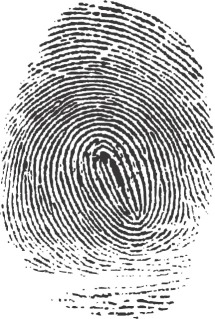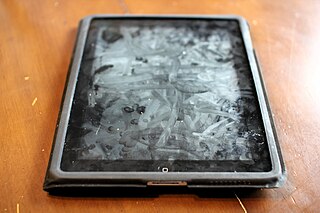
Authentication is the act of proving an assertion, such as the identity of a computer system user. In contrast with identification, the act of indicating a person or thing's identity, authentication is the process of verifying that identity. It might involve validating personal identity documents, verifying the authenticity of a website with a digital certificate, determining the age of an artifact by carbon dating, or ensuring that a product or document is not counterfeit.

A fingerprint is an impression left by the friction ridges of a human finger. The recovery of partial fingerprints from a crime scene is an important method of forensic science. Moisture and grease on a finger result in fingerprints on surfaces such as glass or metal. Deliberate impressions of entire fingerprints can be obtained by ink or other substances transferred from the peaks of friction ridges on the skin to a smooth surface such as paper. Fingerprint records normally contain impressions from the pad on the last joint of fingers and thumbs, though fingerprint cards also typically record portions of lower joint areas of the fingers.
Biometrics are body measurements and calculations related to human characteristics. Biometric authentication is used in computer science as a form of identification and access control. It is also used to identify individuals in groups that are under surveillance.
A retinal scan is a biometric technique that uses unique patterns on a person's retina blood vessels. It is not to be confused with other ocular-based technologies: iris recognition, commonly called an "iris scan", and eye vein verification that uses scleral veins.
In the context of information security, and especially network security, a spoofing attack is a situation in which a person or program successfully identifies as another by falsifying data, to gain an illegitimate advantage.
Speaker recognition is the identification of a person from characteristics of voices. It is used to answer the question "Who is speaking?" The term voice recognition can refer to speaker recognition or speech recognition. Speaker verification contrasts with identification, and speaker recognition differs from speaker diarisation.
Mutual authentication or two-way authentication refers to two parties authenticating each other at the same time in an authentication protocol. It is a default mode of authentication in some protocols and optional in others (TLS).
Keystroke dynamics, keystroke biometrics, typing dynamics andtyping biometrics refer to the detailed timing information that describes each key press related event that occurs when a user is typing on a keyboard.
A card reader is a data input device that reads data from a card-shaped storage medium. The first were punched card readers, which read the paper or cardboard punched cards that were used during the first several decades of the computer industry to store information and programs for computer systems. Modern card readers are electronic devices that can read plastic cards embedded with either a barcode, magnetic strip, computer chip or another storage medium.
M2SYS Technology is a global biometric identification management company that provides biometric identity management software, and hardware along with enterprise software applications to several markets including; public safety, workforce management, point of sale, healthcare, education, child care, transportation security, banking and membership management. They offer Software Development Kits to software vendors that want to add biometric identification to their applications directly to end users.

Vein matching, also called vascular technology, is a technique of biometric identification through the analysis of the patterns of blood vessels visible from the surface of the skin. Though used by the Federal Bureau of Investigation and the Central Intelligence Agency, this method of identification is still in development and has not yet been universally adopted by crime labs as it is not considered as reliable as more established techniques, such as fingerprinting. However, it can be used in conjunction with existing forensic data in support of a conclusion.
In order to identify a person, a security system has to compare personal characteristics with a database. A scan of a person's iris, fingerprint, face, or other distinguishing feature is created, and a series of biometric points are drawn at key locations in the scan. For example, in the case of a facial scan, biometric points might be placed at the tip of each ear lobe and in the corners of both eyes. Measurements taken between all the points of a scan are compiled and result in a numerical "score". This score is unique for every individual, but it can quickly and easily be compared to any compiled scores of the facial scans in the database to determine if there is a match.
A whole new range of techniques has been developed to identify people since the 1960s from the measurement and analysis of parts of their bodies to DNA profiles. Forms of identification are used to ensure that citizens are eligible for rights to benefits and to vote without fear of impersonation while private individuals have used seals and signatures for centuries to lay claim to real and personal estate. Generally, the amount of proof of identity that is required to gain access to something is proportionate to the value of what is being sought. It is estimated that only 4% of online transactions use methods other than simple passwords. Security of systems resources generally follows a three-step process of identification, authentication and authorization. Today, a high level of trust is as critical to eCommerce transactions as it is to traditional face-to-face transactions.

A smudge attack is an information extraction attack that discerns the password input of a touchscreen device such as a cell phone or tablet computer from fingerprint smudges. A team of researchers at the University of Pennsylvania were the first to investigate this type of attack in 2010. An attack occurs when an unauthorized user is in possession or is nearby the device of interest. The attacker relies on detecting the oily smudges produced and left behind by the user's fingers to find the pattern or code needed to access the device and its contents. Simple cameras, lights, fingerprint powder, and image processing software can be used to capture the fingerprint deposits created when the user unlocks their device. Under proper lighting and camera settings, the finger smudges can be easily detected, and the heaviest smudges can be used to infer the most frequent input swipes or taps from the user.
Eye vein verification is a method of biometric authentication that applies pattern-recognition techniques to video images of the veins in a user's eyes. The complex and random patterns are unique, and modern hardware and software can detect and differentiate those patterns at some distance from the eyes.
Identity-based security is a type of security that focuses on access to digital information or services based on the authenticated identity of an entity. It ensures that the users and services of these digital resources are entitled to what they receive. The most common form of identity-based security involves the login of an account with a username and password. However, recent technology has evolved into fingerprinting or facial recognition.

A biometric device is a security identification and authentication device. Such devices use automated methods of verifying or recognising the identity of a living person based on a physiological or behavioral characteristic. These characteristics include fingerprints, facial images, iris and voice recognition.

A pulse watch, also known as a pulsometer or pulsograph, is an individual monitoring and measuring device with the ability to measure heart or pulse rate. Detection can occur in real time or can be saved and stored for later review. The pulse watch measures electrocardiography data while the user is performing tasks, whether it be simple daily tasks or intense physical activity. The pulse watch functions without the use of wires and multiple sensors. This makes it useful in health and medical settings where wires and sensors may be an inconvenience. Use of the device is also common in sport and exercise environments where individuals are required to measure and monitor their biometric data.
Passwordless authentication is an authentication method in which a user can log in to a computer system without the entering a password or any other knowledge-based secret. In most common implementations users are asked to enter their public identifier and then complete the authentication process by providing a secure proof of identity through a registered device or token.
Identity replacement technology is any technology that is used to cover up all or parts of a person's identity, either in real life or virtually. This can include face masks, face authentication technology, and deepfakes on the Internet that spread fake editing of videos and images. Face replacement and identity masking are used by either criminals or law-abiding citizens. Identity replacement tech, when operated on by criminals, leads to heists or robbery activities. Law-abiding citizens utilize identity replacement technology to prevent government or various entities from tracking private information such as locations, social connections, and daily behaviors.







